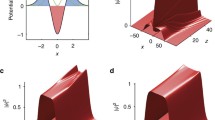Abstract
The weak nonlinearity limit of the second-harmonic generation in a medium with variable second-order susceptibility, changing along the direction of propagation of interacting waves according to the hyperbolic secant law, is considered. It is shown that the variation of the second harmonic’s normalized intensity with the spatial coordinate is given in terms of the solution to an auxiliary linear problem, which is known as the Rosen-Zener quantum two-level model. The final intensity of the second harmonic at the exit from the medium is calculated and analyzed. It is shown that, for the particular Rosen-Zener profile under consideration, because of its inherent properties, the variation range of the peak susceptibility of the layer for which the medium can be strictly considered as weakly nonlinear is narrower than the corresponding parameter range for a homogeneous medium.
Similar content being viewed by others
References
Y. R. Shen, The Principles of Nonlinear Optics (Wiley, New York, 1984; Nauka, Moscow, 1989); A. Yariv, Quantum Electronics (Wiley, New York, 1989; Sovetskoe Radio, Moscow, 1973); P. N. Butcher and D. Cotter, The Elements of Nonlinear Optics (Cambridge Univ. Press, Cambridge, 1991).
J. A. Armstrong, N. Bloembergen, J. Ducuing, and P. S. Pershan, Phys. Rev. 127, 1918 (1962).
A. Ishkhanyan, J. Javanainen, and H. Nakamura, J. Phys. A 38, 3505 (2005).
B. W. Shore, The Theory of Coherent Atomic Excitation (Wiley, New York, 1990); E. E. Nikitin and S. Ya. Umanski, Theory of Slow Atomic Collisions (Springer, Berlin, 1984).
N. Rosen and C. Zener, Phys. Rev. 40, 502 (1932).
Handbook of Mathematical Functions, Ed. by M. Abramowitz and I. A. Stegun (Dover, New York, 1965; Nauka, Moscow, 1979); A. Erdélyi, W. Magnus, F. Oberhettinger, and F. G. Tricomi, Higher Transcendental Functions (McGraw-Hill, New York, 1953).
F. G. Tricomi, Integral Equations (Dover, New York, 1985; Inostrannaya Literatura, Moscow, 1960); T. A. Burton, Volterra Integral and Differential Equations (Academic, New York, 1983); R. K. Miller, Nonlinear Volterra Integral Equations (Benjamin, New York, 1971).
V. Ghazaryan, J. Contemp. Phys. (Armenian Ac. Sci.) 40(1), 1 (2005).
A. M. Ishkhanyan, J. Phys. A 33, 5539 (2000); A. M. Ishkhanyan, Opt. Commun. 176, 155 (2000); A. M. Ishkhanyan, J. Phys. A 30, 1203 (1997).
A. Ishkhanyan, M. Mackie, A. Carmichael, et al., Phys. Rev. A 69, 043612 (2004).
Author information
Authors and Affiliations
Corresponding author
Additional information
Original Text © Astro, Ltd., 2008.
Rights and permissions
About this article
Cite this article
Ishkhanyan, A., Manukyan, A. & Joulakian, B. Second-harmonic generation in a layer with variable susceptibility. Laser Phys. 18, 886–893 (2008). https://doi.org/10.1134/S1054660X0807013X
Received:
Published:
Issue Date:
DOI: https://doi.org/10.1134/S1054660X0807013X




